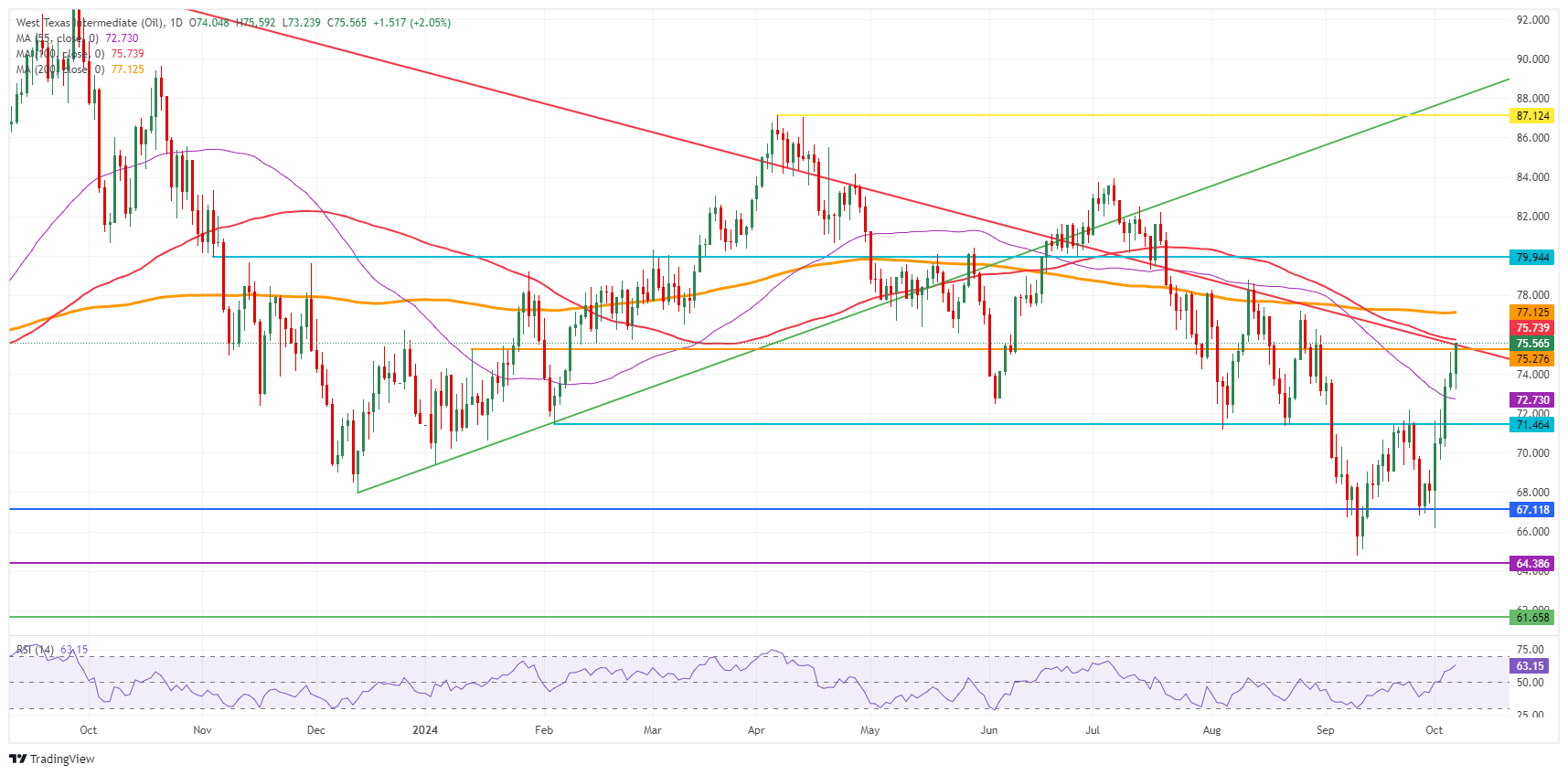- Crude oil rises more than 2% on Monday after the Biden administration verbally rejected attacking Iranian oil fields.
- Markets are pricing in the risk premium even higher, with uncertainty now dominating over Israel’s next step in this escalation.
- The US Dollar Index remains near recent highs ahead of a packed Monday with Fed events.
Crude oil is rising rapidly on Monday after Israel received a red light on its request to bomb Iranian oil fields. United States (US) President Joe Biden said on Friday that it was under consideration, suggesting other targets should be pursued instead. With no headlines indicating that the Biden administration has given the green light, it appears that Israel will resort to other actions, adding even more uncertainty.
The US Dollar Index (DXY), which tracks the performance of the dollar against six other currencies, is trading broadly flat on Monday. All eyes will be on the release of the US Consumer Price Index (CPI) for September later this week. In the run-up to those numbers, markets will hear from no less than four Fed officials this Monday.
At the time of writing, WTI crude oil is trading at $75.78 and Brent crude at $79.53.
Oil news and market drivers: Concern in markets due to uncertainty in Israel
- Oil production is suspended at the major Kashagan oil and gas field due to the start of a scheduled overhaul, Kazakhstan’s Ministry of Energy confirms to Interfax.
- A Goldman Sachs note by senior analyst Daan Struyven expects Brent to hit $90 when Iranian exports are disrupted, Bloomberg reports.
- Tension in the Middle East remained high over the weekend with Israel sending troops to northern Gaza, while airstrikes and ground maneuvers were carried out in Lebanon at the same time, Reuters reported.
- Options markets are seeing a wave of buyers with an appetite for puts, driving Brent implied volatility to the highest level in almost a year, while fund managers added more net long positions to their portfolios, it reported. the Chicago Futures Trading Commission.
Technical analysis of oil: Here goes $75.00
Crude oil prices are rising again, with WTI surpassing $75.00 for the first time since late August. The Biden administration’s failure to fully confirm or reject Israel’s request to attack Iranian oil fields is creating even more uncertainty for markets. With uncertainty comes the risk premium, which is being valued this Monday.
The current crude oil price level, with the red descending trend line and the 100-day SMA on the chart below at $75.74 just above, makes that region very difficult to overcome . Once broken, the 200-day SMA at $77.12 should refute any further upside.
On the downside, old resistances have become supports. First is the 55-day SMA at $72.73, which acts as a potential first line of defense in case of any pullback. A little further down, $71.46 comes into play as second support before looking again at the big $70.00 and $67.11 as final support for traders to buy on the dip.
US WTI Crude Oil: Daily Chart
WTI Oil FAQs
WTI oil is a type of crude oil that is sold in international markets. WTI stands for West Texas Intermediate, one of the three main types that include Brent and Dubai crude. WTI is also known as “light” and “sweet” for its relatively low gravity and sulfur content, respectively. It is considered a high-quality oil that is easily refined. It is sourced in the United States and distributed through the Cushing facility, considered “the pipeline junction of the world.” It is a benchmark for the oil market and the price of WTI is frequently quoted in the media.
Like all assets, supply and demand are the main factors that determine the price of WTI oil. As such, global growth can be a driver of increased demand and vice versa in the case of weak global growth. Political instability, wars and sanctions can alter supply and impact prices. The decisions of OPEC, a group of large oil-producing countries, is another key price factor. The value of the US Dollar influences the price of WTI crude oil, as oil is primarily traded in US dollars, so a weaker Dollar can make oil more affordable and vice versa.
Weekly oil inventory reports published by the American Petroleum Institute (API) and the Energy Information Agency (EIA) influence the price of WTI oil. Changes in inventories reflect the fluctuation of supply and demand. If the data shows a decline in inventories, it may indicate an increase in demand, which would drive up the price of oil. An increase in inventories can reflect an increase in supply, which drives down prices. The API report is published every Tuesday and the EIA report the next day. Their results are usually similar, with a difference of 1% between them 75% of the time. EIA data is considered more reliable since it is a government agency.
OPEC (Organization of the Petroleum Exporting Countries) is a group of 13 oil-producing nations that collectively decide member countries’ production quotas at biannual meetings. Their decisions often influence WTI oil prices. When OPEC decides to reduce quotas, it can restrict supply and drive up oil prices. When OPEC increases production, the opposite effect occurs. OPEC+ is an expanded group that includes ten other non-OPEC member countries, including Russia.
Source: Fx Street
I am Joshua Winder, a senior-level journalist and editor at World Stock Market. I specialize in covering news related to the stock market and economic trends. With more than 8 years of experience in this field, I have become an expert in financial reporting.








